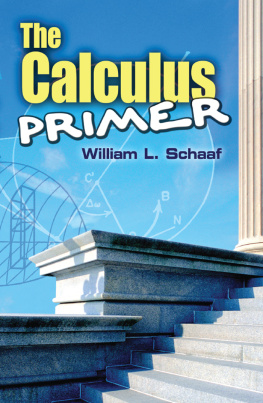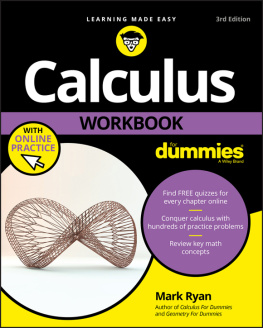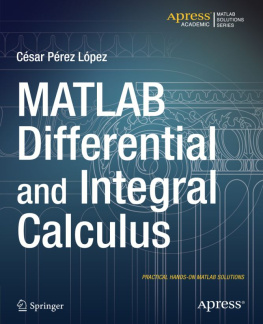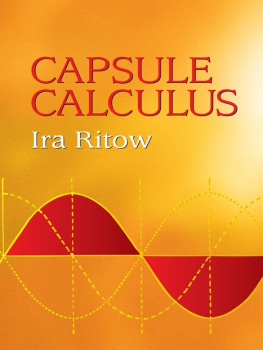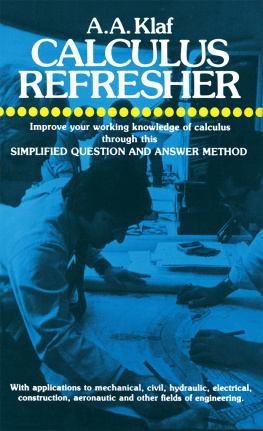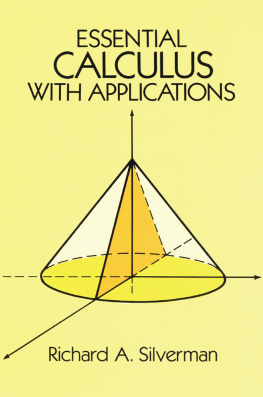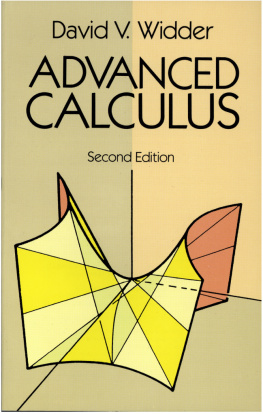The Calculus PRIMER William L. SchaafDover Publications, Inc.Mineola, New YorkBibliographical Note This Dover edition, first published in 2011, is an unabridged republication of The Calculus, which was originally published in 1963 by Doubleday and Company, Inc., New York. The main text of this book begins on ; no pages have been omitted. Library of Congress Cataloging-in-Publication Data Schaaf, William Leonard, 1898 The calculus primer / William L. Schaaf p. cm.
Originally published: The calculus. Garden City, N.Y. : Doubleday, 1963. Includes bibliographical references and index. ISBN-13: 978-0-486-17264-4 ISBN-10: 0-486-48579-X (alk. Calculus. I. I.
Schaaf, William Leonard, 1898 Calculus. II. Title. QA303.2.S37 2011 515dc23 20110171575 Manufactured in the United States by Courier Corporation 48579X01 www.doverpublications.com
PREFACE
It is our express purpose in this book to present a comprehensive yet concise introductory course in the Differential and Integral Calculus, covering all the topics usually included in a first course. We have endeavored to achieve clarity of exposition, and have introduced many carefully worked out model examples. A generous number of diagrams supplements the development throughout, and in addition there is a special section of curves for reference toward the end of the book.
The development of the subject is direct and straightforward, without the distraction of unimportant details. Consequently, the demands of mathematical rigor, though fully recognized, have been less stressed in this presentation. Since the needs of the beginner have constantly been kept in mind, the emphasis is placed upon fundamental concepts: functions, derivatives, differentiation of algebraic functions, differentiation of transcendental functions, partial differentiation, indeterminate forms, general and special methods of integration, the definite integral, partial integration, and other fundamentals. Ample exercises have been furnished after each important topic to enable the student to test his grasp of the subject matter before he proceeds to the next topic. Thus, the book is appropriate not only for classroom use, but also notably for review purposes and for home study. W. L. S. CONTENTS
INTRODUCTION
The creation of Analytic Geometry by Descartes in the early part of the seventeenth century was a milestone of tremendous significance.
CONTENTSINTRODUCTION
The creation of Analytic Geometry by Descartes in the early part of the seventeenth century was a milestone of tremendous significance.
Indeed, it was the beginning of modern mathematics in the broad perspective of history. (Modern mathematics in the sense of contemporary mathematics did not commence until about 1900, with the advent of functional analysis, abstract spaces, set theory, and symbolic logic.) This great step of recognizing the relation between the numbers of algebra and the entities of geometry once having been taken, it is perhaps not surprising that further advances were soon to follow, culminating in the invention of the Calculus by ISAAC NEWTON and by GOTTFRIED LEIBNIZ. This was a classic illustration of nearly simultaneous, but presumably independent creation. In this instance the invention was attended with unfortunate and, at times, bitter dispute. Newton had been using his new method of fluxions since 1674 or even earlier, but he did not publish a direct statement of his method until 1687. Leibniz, using a different approach and a different symbolism, published his first statement in 1684.
Each accused the other of plagiarism, yet from the vantage point of historical perspective there can be little doubt that each must be credited with independent creation. What is perhaps more important is the fact that the ground had been prepared for this new advance by many predecessors over a long period of time. There are traces of the methods of the Calculus discernible even among the Greeks. Thus DEMOCRITUS (c.400 B.C.) suspected the relation that exists between the volumes of cones and cylinders, although he was unable to prove it. But the influence of ZENOS famous paradoxes about infinitely small quantities discouraged the further use of infinitesimal quantities from the study of geometry. Shortly thereafter another forerunner of the Calculus came into prominence, the method of exhaustions.
This was first used in connection with the circle, and consisted essentially of doubling and redoubling the number of sides of a regular inscribed polygon on the assumption that as the process of doubling is continued indefinitely, the difference in area between the circle and the polygon would finally be exhausted. The method was later extended and refined by EUDOXUS (c.360 B.C.). The nearest approach to the process of summation, however, was made by ARCHIMEDES (c.225 B.C.) in connection with his study of the area under a parabola and certain other curves, as well as the volumes of certain well-known solids. No further step toward the Calculus was taken until during or after the Middle Ages. The story is a long and interesting one, and only a few of the high spots can be touched upon here. The astronomer KEPLER (c.1610) developed certain crude methods of integration, in connection with problems of gauging, by which the volume of a solid was regarded as composed of many infinitely small cones or infinitely thin disks.
His contemporary, the Jesuit priest BONAVENTURA CAVALIERI, made considerable use of the so-called method of indivisibles, in accordance with which he regarded a surface as the smallest element of a solid, a line as the smallest element of a surface, and a point as the smallest element of a line. Although the method lacked logical rigor and was essentially intuitive in nature, the results obtained by its application were valid. Another contemporary, ROBERVAL, using a similar method, but employing the device of an infinite number of infinitely narrow rectangular strips, succeeded in solving many problems of finding lengths of curves as well as areas and volumes. About 1636 the French mathematician FERMAT extended the methods of his predecessors, attacking also the problem of finding maximum and minimum values of curves, focusing attention on the determination of tangents to a curve. In the course of his work, Fermat enunciated the general principle for determining a tangent, substantially equivalent to the modern method of setting the derivative of a function equal to zero. Thus Fermat may also, in a very real sense, be regarded as a co-inventor of the Calculus.
Two other fertile minds contributed to the pregnant atmosphere of this eventful periodJOHN WALLIS and ISAAC BARROW, both British mathematicians. Wallis Arithmetica Infinitorum, which appeared in 1655, showed how to apply methods of summation to the determination of the areas of triangles, the lengths of spirals, and the volumes of paraboloids and other solids. Wallis freely acknowledged his indebtedness to Torricelli, Cavalieri, Christopher Wren, and others. While Wallis was devoting his efforts to problems of integration, Barrow (1663) drew attention to the problem of tangents and methods of differentiation. He recognized the fact that integration is the inverse of differentiation. Newton at various times employed three different methods of procedure.
At first he made some use of infinitely small quantities, but soon recognized that this was not a sound basis on which to operate. His second method, the method of fluxions, was a unique contribution. According to the concept of fluxions, a curve was considered as being generated by a moving point. The change in the position of a point in an infinitely short time was called its momentum; this momentum divided by the infinitely short time was the fluxion. If the flowing quantity was
Next page
